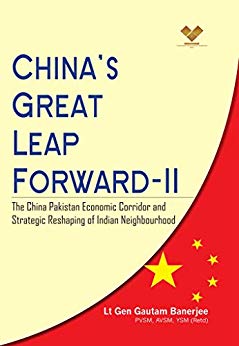The Great Leap Forward was a campaign run in the People’s Republic of China from 1958 to 1962. Chairman Mao Zedong led the campaign and the aim was to transform an agricultural economy to a socialist society through rapid industrialisation and collectivisation. It led to an economic and social disaster. The policies marginalised Mao, compelling him to launch the Cultural Revolution in 1966 to re-establish his supremacy. Ultimately China stabilised after Mao’s death and Deng Xiaopingcoming to power as the supreme leader of People’s Republic of China.
The book deals with the China Pakistan Economic Corridor (CPEC) and its strategic reshaping of Indian neighbourhood. Rightly, the author has named the book as Great Leap Forward- II. The book has two Parts and nine chapters. There are five Chapters in Part One and four Chapters in Part Two.
Part-One provides a description of the CPEC Scheme. Chapter 1 of this Part is titled, ‘The Leap and its Landing’. The Chapter focuses on the schemes of One Belt One Road (OBOR), CPEC and Maritime Silk Routes. Though the schemes are economically enticing, there are serious drawbacks with regards to sovereignty, insertion of military connotations in China’s favour, and finally, the ethnic-cultural-political fractures that are embedded within the collaborating nations. Chapter 2 deals with ‘The Making of a Great Corridor’ and gives all details regarding the CPEC. To start with, the alignments which constitute the CPEC are explained as enumerated below;-
- Southward from Chilas, the already existing Eastern Alignment also referred to as the Motorway, runs along the alignment Manshera-Abbotabad-Rawalpindi-Multan-Sukkur-Hyderabad-Karachi-Gwadar. This would be Route 3 and from the Khunjerab Pass to Gwadar would be 2781 km.
- Rote 2 would be the Indus Highway which would be Abbotabad-Dera Ghazi Khan Sukkur-Karachi/Khuzdar-Gwadar, 2756 kilometres long from the Karokaram and up to Gwadar.
- Route 1 is yet to be developed and would be aligned South West along Chilas – Mingora-Mardan-Peshawar-Derajat Basin- Dera Ismail Khan –Quetta-Kuzdar-Gwadar port. Length would be 2674 Km.
- In the long run a main route would be developed through Islamabad along with many other arterial roads.
Currently, all roads are under development through the initial grant of $ 11 billion from China. Apart from road construction, the focus would be on generation of 12000 megawatt of power as also other projects of renewable energy like wind and solar. Further the development of Gwadar port and the township is proceeding at a deliberate pace. The author has correctly analysed that there are three stake holders in the entire project. These are China, Pakistan and the local population. As all projects are being tentatively finalised, each tries to get the most while offering the least. Currently the committed expenditure is $ 18.96 billion and some expenditure would need to be pruned to remain within the budget. The CPEC would bring Pakistan tightly under the Chinese fold and this would be a great factor in China’s intent of dominating the region.
The remaining three Chapters of Part One deal with the problems to the project. These are the cultural differences between the Han and the Muslim Uighur communities, the problems in the Federally Administered Frontier Areas (FATA) region and the Baloch resistance. There are technical problems due to terrain and environmental issues. Apart from these, there are issues pertaining to sovereignty and security as also Pakistan’s economy which is in doldrums. Further, the project is to come up under formidable conditions. Overall, the project benefits Pakistan and China by improving their connectivity. The author correctly states that China could have adopted a rational process of obtaining India’s approval rather than undertaking the project through disputed regions with no considerations for Indian sentiments.
Part-Two of the book is about political and strategic appreciation of the CPEC. Chapter 6 covers China’s position for ‘Regional Superintendence’. This Chapter brings out the details of OBOR or BRI at investments of $ 1 trillion. The project, apart from utilising idle Chinese investments, would bring great returns for the Chinese economy. It also comprises pipelines, railways, ports, power plants, industrial parks and other economic installations. Major connectivity alignments are as enumerated below:-
- CPEC.
- China-Central Asian Republics-West Asia (Iran-Turkey) – Europe.
- China – Mongolia – Russia corridor aligned with the Trans-Siberian Railway.
- Multi stage rail corridor from Lanzhou – Urumqi – Kazakhstan – Russia - Belarus – East Europe.
- Central Tibet – Nepal – coastal Eastern India.
- Yunnan – Myanmar – North East India – Bangladesh – West Bengal also known as Bangladesh – China – India – Myanmar (BCIM) economic corridor.
- China – Myanmar Economic Corridor (CMEC) to connect Kunming to Kyaukphyu port in Myanmar.
- Complimenting them would be the sea lanes of communications to expand transportation capacities astride China Seas, Java Seas, the Bay of Bengal, Arabian Sea and the Indian Ocean. This would be part of the Maritime Silk Route (MSR).
OBOR is a tempting proposition for many countries but could ultimately land the country in a debt trap, thereby losing a part of its real estate and sovereignty to China. China thus becomes the superintendent of the region. The next Chapter is a strategic appreciation of the CPEC. The Western Highway linking Lhasa with Xinjiang has been critical for the Chinese since the 1960s. The OBOR has ensured that the Shaksgam Valley, which Pakistan acceded to China in 1963, provides strategic depth to CPEC. With the current military reforms, CPEC falls under the Western Theatre Command which is capable of dealing with Indian military posturing if so undertaken.
The other aspects focus on the Implications for India. As aptly stated, CPEC scheme is an act of brazen disregards for India’s sovereign rights. Further, Gwadar Port itself is a major concern as China is in the habit of using civilian ports for military purposes. The book rightly states that India must build its national strength and not be contained by China’s OBOR and MSR.
The concluding Chapter is extremely important in analysing the military angle. Undoubtedly, China’s military deployment along the CPEC region is excessive. It is obvious that China has identified India as a potentially dangerous strategic adversary who needs to be contained for the Chinese dream to be fulfilled. India has therefore rightly adopted defence partnerships with Bangladesh, Afghanistan, Sri Lanka and Mauritius. The OBOR would enable the PLA to be more arbitrary and assertive. Further, it would enhance Pakistan’s defence capability. Strengthening the Indian Armed Forces is a necessity to keep the predators at bay.
The book is analytical and must read for officers posted in the Ministry of Home, Ministry of Defence and Ministry of External Affairs. Further all officers of the Indian Armed Forces must read the book to comprehend Chinese intentions.











Post new comment